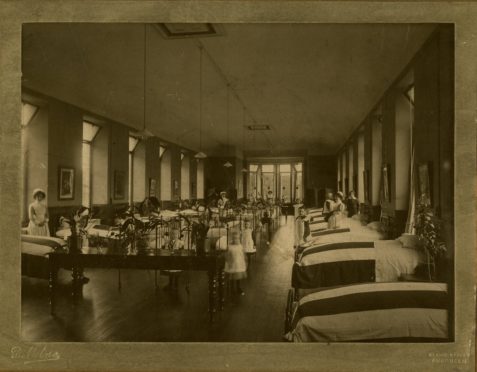When war broke out in August 1914, few people could have imagined its impact.
But new research carried out by NHS Grampian’s archivisit Fiona Musk has revealed the concerns of medical staff a century ago as they tried to prepare for a bombardment of Aberdeen.
While it was originally hoped the hostilities would be over by Christmas 1914, the managers of the Royal Aberdeen Children’s Hospital took no chances.
>> Keep up to date with the latest news with The P&J newsletter
They decided that patients should be moved out of the Castle Terrace building to somewhere further away from the harbour, which was subject to possible air raids.
The outbreak of the conflict caused other problems – such as staffing. The 1914 annual report noted most of the medical and surgical staff had been mobilised and had to give up their jobs.
The directors also had to organise the evacuation of the hospital to other premises, and moved into Kepplestone House in Rubislaw on January 1, 1915.
Yet they remained anxious about the possibility of health facilities coming under attack, and not without reason.
Ms Musk said: “The threat of an air raid was always present and a note in the admission registers for Kingseat Hospital at Newmachar recorded that ‘a German airship passed about 2am on May 3, 1916 on the way back to Germany’.
“Her propellers were heard distinctly by night staff. The airship had dropped bombs near Lumsden and Insch, before heading back over the north sea and ditching off the Norwegian coast.
“However, progress was made at Kepplestone House and a new open air ward was introduced, which was of great benefit to the children.
“The 1916 annual report said it was possible “with the aid of blankets and hot water bottles” to keep the children warm in all weathers, even the most cold. The fresh air was also noted to help aid the quick healing of wounds.”
During 1917, the hospital moved back to Castle Terrace and its directors decided to restart their fundraising for a new building, having put the project on hold, due to the importance of other wartime appeals.
And they issued an impassioned plea for greater support to help them look after the next generation.
They said: “The necessity for the care of child life was never so great as it is today.
“We trust that the response to the new appeal will be of such a generous character to enable us to proceed with the erection of the new hospital immediately after the cessation of hostilities.
“There could be no more suitable peace offering or worthier memorial to the memory of those who have, with magnificent patriotism, made the supreme sacrifice and thereby compelled a world’s admiration and esteem.
“That memorial must not be merely a cold and lifeless one in stone or bronze, but one which will serve some noble end and give expression by its beneficent work to our pride, our gratitude, and our sorrow.”
However, it was many years before their proposals reached fruition.
Ms Musk added: “The implementation of the Joint Hospitals Scheme in the early 1920s meant the directors’ vision of a war memorial hospital wasn’t met.
“But the Royal Aberdeen Children’s Hospital was the first to open on the new Foresterhill site in 1929, in part because of the successful fundraising carried out for its building fund.
“Many changes have since taken place, not least the opening of its third incarnation in 2003, but the opinion of the directors in 1917 is still felt keenly today.”
